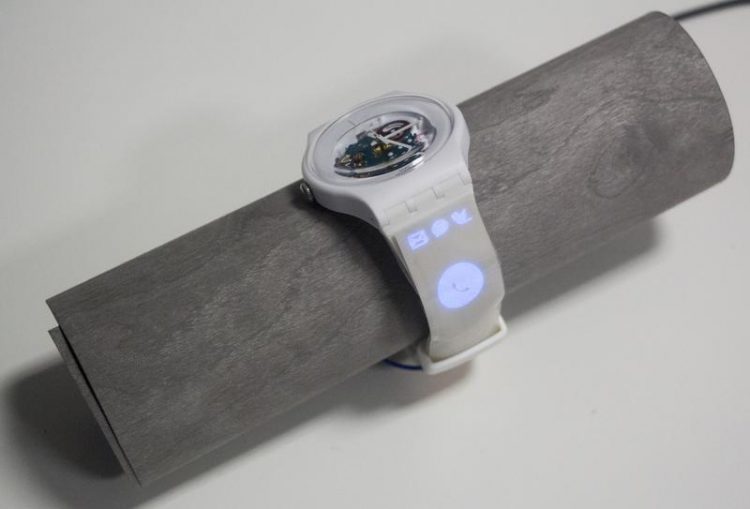Cebit 2015: DIY Printing Custom Touch-Sensitive Displays

Computer scientists from Saarland University have developed a technique that could enable virtually anyone to print out customized displays of their own. Credit: Embodied Interaction Group/MMCI
The postcard shows a vintage automobile. With the push of a button, the rear axis and the steering wheel rod of the vehicle light up in the same colour. This is made possible by two parts of a flexible touchscreen display that match up exactly with the shape of the car parts depicted.
A team of computer scientists around Saarland University researcher Jürgen Steimle printed the display on a regular inkjet printer. The DIY display is electroluminescent: It emits light when under an electric current. The same effect is used to illuminate dashboards in vehicles at night. Steimle is head of the research group “Embodied Interaction” within the Cluster of Excellence “Multimodal Computing and Interaction”, where Simon Olberding also conducts his research.
“So far, nothing like this has been possible,” Olberding says. “Displays were produced for the masses, never for one individual user.” That is precisely what Olberding and Steimle wanted to change. The technique they developed is as follows: Users can create a digital template of the display they are designing, using software like Microsoft Word or Powerpoint.
Making use of one of the two methods the researchers have been presenting, the template can now simply be printed out. Both methods have their distinctive strengths and weaknesses, but either can be performed by laymen in minutes, or in two to four hours, depending on the exact procedure. The printed results are relatively high-resolution displays that are just one tenth of a millimeter thick.
To cover an entire standard printer page with a display layer currently costs around 20 Euros, the most expensive part being the special ink that is required.
But as the method is not limited to paper, even plastics, leather, ceramics, stone, metal or wood could be used as a base for all kinds of two-dimensional and three-dimensional printed shapes. The display surface can be constructed from a single segment (a shape, outline, pattern, or raster graphics), from several segments or from otherwise structured matrices.
“With this method, we can even print touch-sensitive displays,” says Olberding. And the conceivable applications are diverse: Displays could be integrated into almost every kind of everyday object – into paper objects, but also into furniture or household items, briefcases or clothing.
So you could modify the wristband of a watch with a display in such a way that it lights up when an instant message arrives, for example. “And if we now combine our approach with 3-D printing, we can print three-dimensional objects, which are able to display information and respond to touch as well,” says Steimle.
Computer science and informatics at Saarland University
The Department of Computer Science forms the core of the informatics landscape at Saarland University. A further seven internationally renowned research institutes are located in the immediate vicinity on campus. As well as the two Max Planck Institutes for Informatics and for Software Systems, the Saarbrücken campus is also home to the German Research Center for Artificial Intelligence, the Intel Visual Computing Institute, the Center for IT Security, Privacy and Accountability (CISPA) and the Cluster of Excellence ‘Multimodal Computing and Interaction’.
A short video is available here: http://youtu.be/LiD7dnqY034
Media Inquiries:
Dr. Jürgen Steimle
Cluster of Excellence “Multimodal Computing and Interaction “
Phone: +49 681 302-71935
Email: jsteimle(at)mmci.uni-saarland.de
Simon Olberding
Cluster of Excellence “Multimodal Computing and Interaction “
Phone: +49 681 302-71937
Email: solberdi(at)mmci.uni-saarland.de
Editor:
Gordon Bolduan
Science Communication
Competence Center Computer Science Saarland
Phone: +49 681 302-70741
Email: bolduan(at)mmci.uni-saarland.de
Note for radio journalists: Phone interviews with Saarland University scientists can be conducted in studio quality using the Radio Codec (via direct-dial IP connection, or the ARD Sternpunkt 106813020001). Interview requests can be made via our press department (+49 681 302-2601).
Media Contact
More Information:
http://www.uni-saarland.deAll latest news from the category: Trade Fair News
Newest articles

First-of-its-kind study uses remote sensing to monitor plastic debris in rivers and lakes
Remote sensing creates a cost-effective solution to monitoring plastic pollution. A first-of-its-kind study from researchers at the University of Minnesota Twin Cities shows how remote sensing can help monitor and…

Laser-based artificial neuron mimics nerve cell functions at lightning speed
With a processing speed a billion times faster than nature, chip-based laser neuron could help advance AI tasks such as pattern recognition and sequence prediction. Researchers have developed a laser-based…

Optimising the processing of plastic waste
Just one look in the yellow bin reveals a colourful jumble of different types of plastic. However, the purer and more uniform plastic waste is, the easier it is to…



